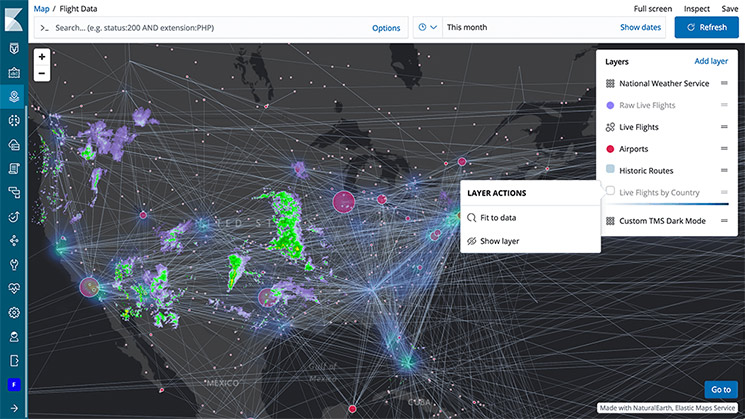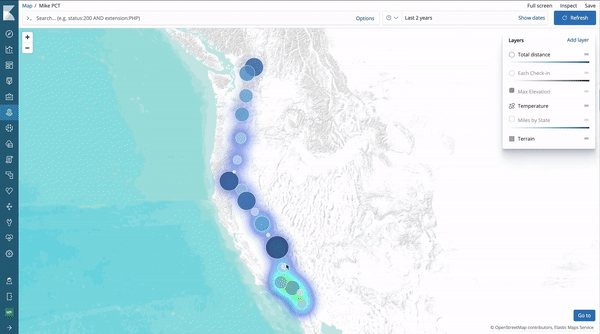PRESS RELEASE
Introducing Elastic Maps: You Know, for Geo...
Elastic N.V. (NYSE: ESTC) has released Elastic Maps, a powerful new application for visual exploration and analysis of geospatial data in Kibana. Elastic Maps is launching as a beta feature in Elastic Stack version 6.7, and ships in the free default distribution. Users can try it by either downloading the Elastic Stack or spinning up a cluster in Elasticsearch Service on Elastic Cloud.
Location is an important part of search, whether it's finding the physical IP locations of bad actors trying to breach your network, defining the geofence for your perfect match on Tinder, or even understanding the poor performance of your website and Content Delivery Network (CDN) in particular geographies. Geo is key to these queries and much more. Elastic Maps builds on the core geo foundation familiar to users of the Elastic Stack to provide an innovative solution that allows the Elastic community to explore and visualize their geospatial data like never before.

"Geospatial data is a key part of many of our use-cases, and we have invested heavily in making it faster and easier over the years," said Shay Banon, founder and CEO of Elastic. "We're super excited to release Elastic Maps, a new solution that leverages our existing query capabilities and provides a more powerful, interactive, and customizable visualization layer, supporting multiple layers, zooming into individual documents, and more."
Multiple Layers, Multiple Sources
Elastic Maps supports the ability to layer data from different sources in a single map. For example, you can overlay weather patterns and flight traffic in the same view to see the impact of weather conditions on flight paths in real time. Or you can embed promotions and sales data in the same map to analyze the impact of a promotion across retail locations.
Full Control of Visual Styling
All properties of the data features on a map can be styled individually. Visual properties like line styles, colors, and symbol sizes can also be driven by values in your data. Users can fully control the visibility of individual layers by using scale ranges to reduce visual clutter. For instance, Elastic Maps can be configured to show individual documents when a user is zoomed in all the way to the postal code level, but only show aggregate counts when zoomed out to the state and country level. All this is made easy with simple sliders.

Map Individual Points and Shapes
With full control over layer visibility, mapping individual points or shapes makes sense when you're at a granular enough zoom level. With Elastic Maps, you can put individual documents as features on a map. You can also deliver additional contextual map data, like boundary layers, by indexing your features into Elasticsearch and bringing them into the Maps app as a layer. Like any other Elasticsearch index, all these documents are fully filterable with Kibana Query Language or Lucene queries.
Out-of-the-Box Base Maps with Elastic Maps Service
Elastic Maps includes out-of-the-box access to the Elastic Maps Service, providing pre-configured vector layers and base layer maps. More experienced analysts also have the option to add their own custom vector shapes, tile map services, or web map services as layers, allowing them to truly make Maps their own.
Powered by Elasticsearch
Elastic Maps is powered by Elasticsearch, and gives users an intuitive way to wield the power of Elasticsearch geospatial querying and aggregation capabilities. Users can expect the same ad hoc query experience and real-time response speeds as they wade through their geodata, alongside other numeric, structured, and unstructured data in Kibana.
Learn More
- Elastic Maps
- Elastic Maps Service
- Elastic Maps solution blog
- Elastic Maps documentation
- Webinar: Elastic Maps for Geospatial Analysis
- For full release details see the Elastic Stack 6.7 press release and blog
- Start a free trial with Elasticsearch Service
- Read about Elastic's customers
About Elastic
Elastic is a search company. As the creators of the Elastic Stack (Elasticsearch, Kibana, Beats, and Logstash), Elastic builds self-managed and SaaS offerings that make data usable in real time and at scale for search, logging, security, and analytics use cases.
Elastic and associated marks are trademarks or registered trademarks of Elastic N.V. and its subsidiaries. All other company and product names may be trademarks of their respective owners.